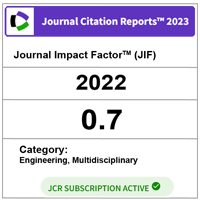ASSESSING EYE FIXATION BEHAVIOUR THROUGH DESIGN EVALUATION OF LAWI AYAM ARTEFACT
DOI:
https://doi.org/10.11113/jt.v77.6884Keywords:
Eye movement, syntactic analysis, pre-existent experience, Lawi Ayam artefact, artefact effectivenessAbstract
There is a need for Malay cultural product knowledge preservation with the convergence of human science to establish the product knowledge development in innovative culture environment in Malaysia. The study uses eye tracking test to understand the user’s cognition and eye behaviour towards the syntactic elements of the cultural artefact (Lawi Ayam – LA) using pre-existent experience. This study was conducted to evaluate the artefact effectiveness and usage efficiency through design preference. Findings from eye tracking were used to analyse the element in LA artefact that attracts the user attention using the time of first fixation and location of fixations. We concluded that the engrossed area of 3 syntactical components; 1) hilt, 2) blade, 3) sheath, revealed the factors of ergonomic rapport, anatomical, physical measurement and multi-material usage to obtain results on design preference and artefact effectiveness. We also found that pre-existent experience was recalled and manipulated effectively when defining the criteria of the syntactical component in dynamic accumulative cognition. Our findings could guide the on-going cognitive information processing on the cultural artefact to support the design-user knowledge preservation. This study recommends the future cultural and heritage product designer to use the user experience of the particular artefact in the designing process.
References
Smedt, J. D., and Cruz, H. D. 2010. Toward an integrative approach of cognitive neuroscience and evolutionanry psychological studies art. Evolutionary Psychology. 8(4): 695-719. Retrieved from www.ejournal.net.
Locher, P., Overbeeke, K., and Wensveen, S. 2010. Aesthetic Interaction: A Framework. Design Issues. 26(2): 70-79.
Siti Mastura M. I., Rahmah B., and Hazreena H. 2013. Demystify user conception for enhancing design-user knowledge. In Verbeke J. & Pak B. (Eds.) Proceedings of The Conference ‘Knowing (by) Designing’, LUCA, Sint-Lucas School of Architecture, Brussel, Belgium. 633-643.
Shamsul, A. B. 2013. Understanding Attitudes and Perceptions for Civil War Battlefield, Interpretive Images, Doctoral dissertation, Virginia Polytechnic Institute and State University, Virginia, USA.
Dupont, L., Antrop, M., and Eetvelde, V. V. 2014. Eye-tracking analysis in landscape perception research: influence of photograph properties and landscape characteristics. Landscape Research. 39(4): 417-432. doi: 10.1080/01426397.2013.773966.
Massaro, D., Savazzi, Di Dio, F. C., Freedberg, D., and Gallese, V. 2012. When Art Moves the Eyes: A Behavioral and Eye-Tracking Study. PLoS ONE. 7(5): e37285. doi:10.1371/journal.pone.0037285
Sivaji, A., and Soo, S. T. 2013. Understanding, Enhancing and Automating HCI Work Practices: Malaysian Case Studies. Procedia-Social and Behavioral Sciences. 97: 656-665.
Tzuaan, S. S., Sivaji, A., Yong, L. T., Zanegenh, M.H.T., and Shan, L. 2014. Measuring Malaysian M-commerce user behaviour. In Computer and Information Sciences (ICCOINS), International Conference. 1-6.
Sivaji, A., and Ahmad W. F. W. 2014. Benefits of Complementing Eye-Tracking Analysis with Think-Aloud Protocol in a Multilingual Country with High Power Distance. Current Trends in Eye Tracking Research. Springer. 267–278.
Locher, P. 2006. The Usefulness of eye movement recordings to subject an aesthetic episode with visual art to empirical scrutiny. Psychology Science. 48(2): 106-114.
Jacob, R. J. K., and Karn, K.S. 2003. Eye tracking in Human-Computer Interaction and Usability Research: Ready to Deliver the Promises. The Mind’s eye: Cognitive The Mind’s Eye: Cognitive and Applied Aspects of Eye Movement Research, 573-603. doi: citeulike-article-id:23101003.
Koski,J., Olson,I. R., and Newcombe, N. S. 2013. Tracking the eyes to see what children remember. Memory. 21(3): 396-407. doi: 10.1080/09658211.2012.735241.
Bélanger, N. N., and Rayner, K. 2013. Frequency and predictability effects in eye fixations for skilled and less-skilled deaf readers. Visual Cognition. 21(4): 477–497. doi:10.1080/13506285.2013.804016.
Sheridan, H., and Reingold, E.M. 2014. Expert vs. novice differences in the detection of relevant information during a chess game: Evidence from eye movements. Front. Psychol. 5:941. doi:10.3389/fpsyg.2014.00941.
Duchowski, A. 2007. Eye Tracking Methodology: Theory And Practice. London: Springer.
Schwarzfischer, K. 2011. The Aesthetic Meaning of Syntactic, Semantic and Pragmatic Gestalt Integrations in Integrative Aesthetics. Gestalt Theory. 33(3/4): 345-362.
Boucharenc, C. 2008. Design For A Contemporary World. Singapore : National University of Singapore.
Fachruddin, Endjat, D., and Rumtiyati, B. 1992. Senjata tradisional Lampung (The traditional weapon in Lampung), Jakarta: Departemen Pendidikan and Kebudayaan Indonesia.
Siti Mastura M.I., Rahmah B., and Nor Azlin H. 2014. Preserving Cultural Product Knowledge: The Design Characteristics and Intangible Qualities of Malay Traditional Hand-combat Artefact, International Journal of Cultural and Creative Industries. 2(1): 18-33.
Hill, H. 1956. The keris and other Malay weapons, Journal of the Malaysian Branch of the Royal Asiatic Society, XXIX (4): 1-85.
Mohd Zainuddin, A. & Mohd Sharim, S. 2007. Senjata Warisan. Kuala Lumpur : Dewan Bahasa dan Pustaka.
Mubin S. 2011.Malay Arts & Crafts. Kuala Lumpur : MBRAS.
Zakaria, A. 2007. Rahsia Keris Dan Senjata Warisan Melayu. D’ Warisan Darul Naim: Kota Bharu, Kelantan.
Shahrum, Y. 1967. Keris Dan Senjata-Senjata Pendek. Kuala Lumpur : Dewan Bahasa dan Pustaka.
Nielsen, J. and Pernice, K. 2009. Eye tracking Methodology: How to Conduct and Evaluate Usability Studies Using Eye tracking. Retrieved from http://www.useit.com/eyetracking/methodology/eyetracking-methodology.pdf.
Rösler, A. 2012. Using The Tobii Mobile Device Stand In Usability Testing On Mobile Devices. Retrieved from http://www.tobii.com
Goh, K.N., Chen, Y.Y., Lai, F.W., Daud S.C., Sivaji, A., and Soo, S.T. 2013. A Comparison of Multiple Usability Testing Methods to Evaluate and Analyze An e-Commerce Website: A Malaysian Case Study on An Online Gift Shop, 10th International Conference on Information Technology - New Generations, in press.
Glaholt, M.G., Wu. M., and Reingold, E.M. 2009. Predicting preference from fixations. Psychology Journal, 7(2): 141– 158. Retrieved on January, Monday, 2014, from www.psychnology.org.
Neilsen, E. 2006. Emerson Combat Karambit. Retrieved on 13 September, 2012, from https://www.swatmag.com/issues/view/march_2006.
Boucharenc C. 2008. Design for A Contemporary World. Singapore: National University of Singapore.
Karana, E., and Hekkert, P. 2010. User-material-product interrelationships in attributing meanings. International Journal of Design. 4(3): 43-52.
Gardner G. B, 1936. Keris & Other Malay Weapon. Singapore: Progressive Publication.
Downloads
Published
Issue
Section
License
Copyright of articles that appear in Jurnal Teknologi belongs exclusively to Penerbit Universiti Teknologi Malaysia (Penerbit UTM Press). This copyright covers the rights to reproduce the article, including reprints, electronic reproductions, or any other reproductions of similar nature.





